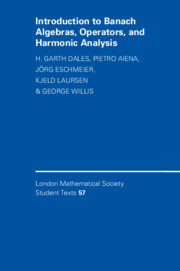Book contents
- Frontmatter
- Contents
- Preface
- Part I Banach algebras
- Part II Harmonic analysis and amenability
- Part III Invariant subspaces
- Part IV Local spectral theory
- 21 Basic notions from operator theory
- 22 Classes of decomposable operators
- 23 Duality theory
- 24 Preservation of spectra and index
- 25 Multipliers on commutative Banach algebras
- Part V Single-valued extension property and Fredholm theory
- Index of symbols
- Subject index
23 - Duality theory
Published online by Cambridge University Press: 29 December 2009
- Frontmatter
- Contents
- Preface
- Part I Banach algebras
- Part II Harmonic analysis and amenability
- Part III Invariant subspaces
- Part IV Local spectral theory
- 21 Basic notions from operator theory
- 22 Classes of decomposable operators
- 23 Duality theory
- 24 Preservation of spectra and index
- 25 Multipliers on commutative Banach algebras
- Part V Single-valued extension property and Fredholm theory
- Index of symbols
- Subject index
Summary
In this chapter we shall explore the surprising relations between decomposability and properties (α) and (δ).
Duality between (β) and (δ)
We have already seen, in Theorem 21.2.8, that T is decomposable if and only if it has both (β) and (δ). But the main reason for emphasizing these two properties is not just that they together describe decomposability – surely (β), in particular, is too technical, and too non-intuitive, to gain fame just for that! Their main conceptual raison d··etre is that they possess a remarkable dual relationship: an operator will have one of them (either one!) precisely when its adjoint operator has the other one. This is the significant conclusion that is provided by the duality theory. (You should note that the adjoint operator is called the dual operator in Part I.)
The duality theory for operators that we are talking about here goes back to Errett Bishop's PhD thesis, published in Bishop (1959), where he developed a spectral theory for an arbitrary bounded linear operator on a reflexive Banach space. Bishop called his development a duality theory, because the operator and its adjoint are involved. In Bishop (1959) we can see, in more or less fully developed form, much of what are now basic tools and concepts of the field, such as the glocal spectral subspaces, and conditions (β) and (δ). Therewas even a precursor of decomposability (which Bishop called duality theory of type 3).
- Type
- Chapter
- Information
- Publisher: Cambridge University PressPrint publication year: 2003

